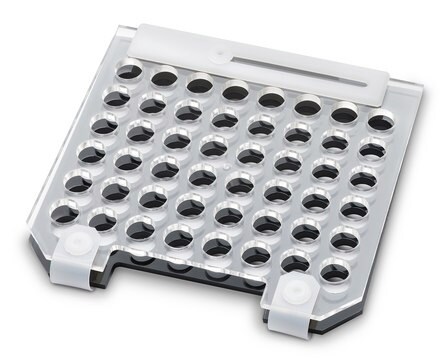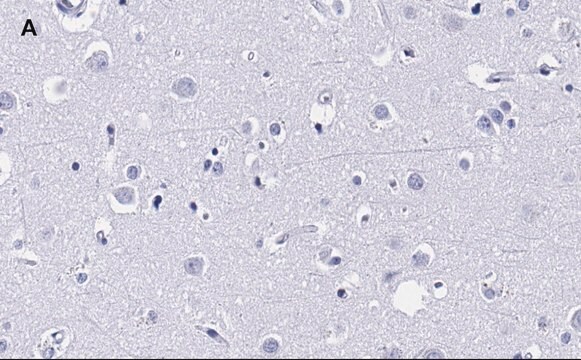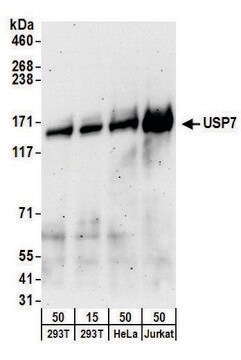ABC225
Anti-phospho USP7 (Ser18) Antibody
from rabbit, purified by affinity chromatography
Synonyme(s) :
Ubiquitin carboxyl-terminal hydrolase 7, Deubiquitinating enzyme 7, Herpesvirus-associated ubiquitin-specific protease, Ubiquitin thioesterase 7, Ubiquitin-specific-processing protease 7
About This Item
Produits recommandés
Source biologique
rabbit
Niveau de qualité
Forme d'anticorps
affinity isolated antibody
Type de produit anticorps
primary antibodies
Clone
polyclonal
Produit purifié par
affinity chromatography
Espèces réactives
human
Réactivité de l'espèce (prédite par homologie)
mouse (based on 100% sequence homology), rat (based on 100% sequence homology), porcine (based on 100% sequence homology), Xenopus (based on 100% sequence homology)
Technique(s)
inhibition assay: suitable (peptide)
western blot: suitable
Numéro d'accès NCBI
Numéro d'accès UniProt
Conditions d'expédition
wet ice
Modification post-traductionnelle de la cible
phosphorylation (pSer18)
Informations sur le gène
human ... USP7(7874)
Description générale
Immunogène
Application
Western Blotting Analysis: 0.02 µg/mL from a representative lot detected phospho USP7 (Ser18) in HeLa cell lysate (Prof. Grigory Dianov, University of Oxford, U.K.).
Western Blotting Analysis: 0.02 µg/mL from a representative lot detected 100 ng of phospho USP7 (Ser18), and not dephosphorylated USP7 (Prof. Grigory Dianov, University of Oxford, U.K.).
Alexa Fluor™ is a registered trademark of Life Technologies.
Apoptosis & Cancer
Apoptosis - Additional
Qualité
Western Blotting Analysis: 0.2 µg/mL of this antibody detected phospho USP7 (Ser18) in 10 µg of HeLa cell lysate.
Description de la cible
Forme physique
Stockage et stabilité
Informations légales
Clause de non-responsabilité
Vous ne trouvez pas le bon produit ?
Essayez notre Outil de sélection de produits.
Code de la classe de stockage
12 - Non Combustible Liquids
Classe de danger pour l'eau (WGK)
WGK 1
Point d'éclair (°F)
Not applicable
Point d'éclair (°C)
Not applicable
Certificats d'analyse (COA)
Recherchez un Certificats d'analyse (COA) en saisissant le numéro de lot du produit. Les numéros de lot figurent sur l'étiquette du produit après les mots "Lot" ou "Batch".
Déjà en possession de ce produit ?
Retrouvez la documentation relative aux produits que vous avez récemment achetés dans la Bibliothèque de documents.
Notre équipe de scientifiques dispose d'une expérience dans tous les secteurs de la recherche, notamment en sciences de la vie, science des matériaux, synthèse chimique, chromatographie, analyse et dans de nombreux autres domaines..
Contacter notre Service technique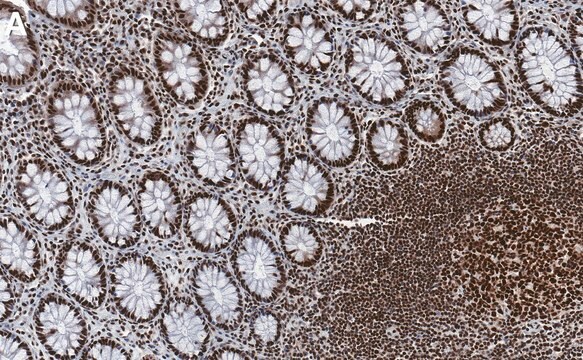

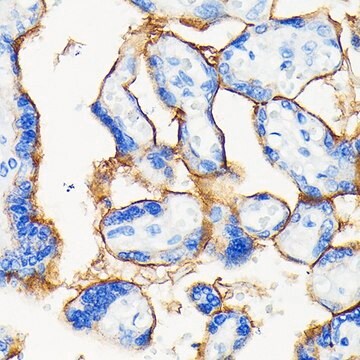

![[Pd(OAc)2]3 reagent grade, 98%](/deepweb/assets/sigmaaldrich/product/structures/508/249/99a0ef2c-b77c-4d73-8ed9-0cca05b6b41f/640/99a0ef2c-b77c-4d73-8ed9-0cca05b6b41f.png)

